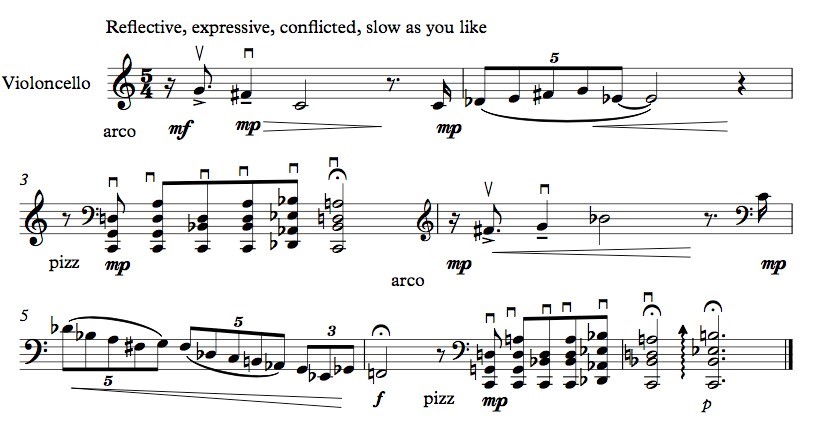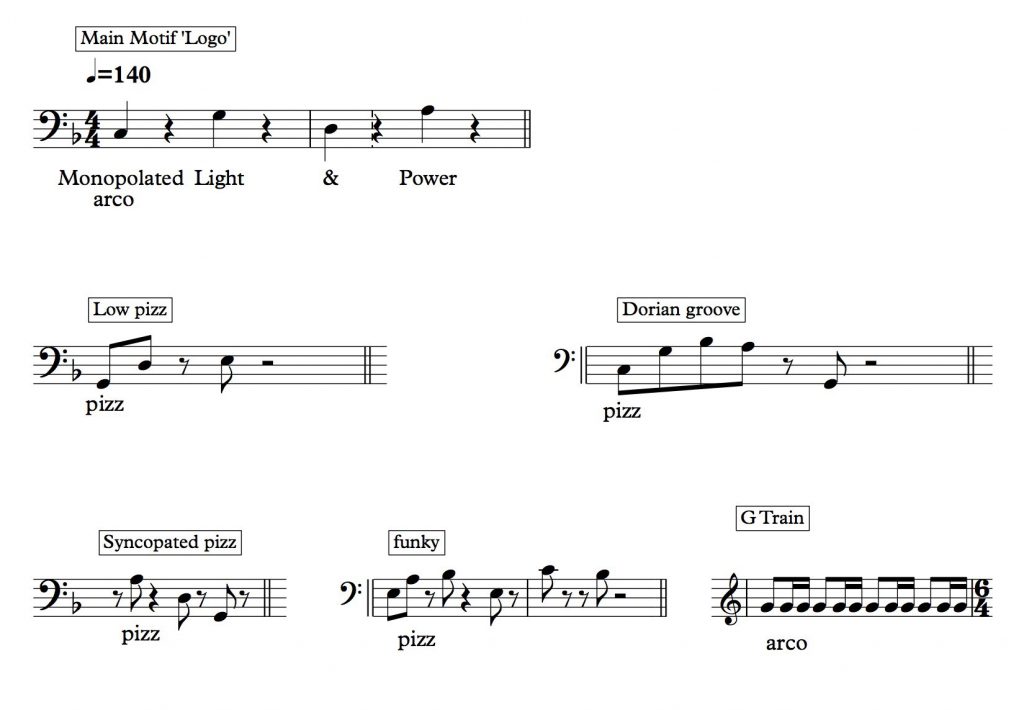
Background
This page provides a summary of the musical process, themes and output from a collaboration at the Arcola Theatre with Clarence Smith (RSC, Star Wars), Laura van der Heijden (cellist and BBC 2012 Young Musician of the Year) and percussionist, composer and arranger Sola Akingbola (Jamiroquai). Writing music for any stage production (especially for such a seminal text as Ellison’s, and with such fine musicians, artists and creatives) is always a pleasure and privilege, but the conventional scoring methodology is, well, conventional: music usually functions in well-established ways, to set time, culture and mood, provide continuity and unity, and underscore with tried and tested methods some emotional signifiers. Sound design (including sounds that happen ‘in the scene’) and non-diegetic scoring (music for the benefit of the audience but unheard by our characters) are distinct worlds. While a superficial treatment of the text would invite a scoring of mid 20th century American Jazz, Invisible Man in fact provides a unique and fascinating opportunity for music creation for a number of reasons.
- Clarence’s insistence that the music – and musicians – share equal performative importance as the narrator, as well as being seen on stage and not ‘in a pit’.
- The collaborative process employed, this was not simply the cyclical process of a director/producer/editor music spotting, a composer writing the notes and the performers performing them, followed by feedback by the director/producer/editor initiating changes. In fact, all collaborators had musical input in terms of placement, tone and message of the music, and equally the musicians had input into text delivery, pacing and so on. This improvisational creative model is something that was evident in the performance itself, the ‘score’ as a vehicle for spontaneous expression and flexibility rather than a fixed work.
- Ellison’s remarkably eclectic musical background and interests allowed, in fact obliged a similarly eclectic approach to the music. Ellison was not only an accomplished jazz trumpet and cornet player, but a serious student of symphonic composition; he was taught by William L. Dawson, a seminal African-American composer who blended the music of Africa within a Western Art Music context, an interest shared by Ellison. Furthermore, Ellison was a ‘thinker-tinker’, collecting, fixing and building radio and phonographic equipment, an audio engineer. All these diverse musical strands of jazz, improvisation, ‘classical’ (for which the cello is an archetypal representation), Africa (clearly referenced in the use of African percussion and rhythms) and electronic music/sound/broadcasting, are integrated in the text, and our musical explorations in the project.
- The prologue includes very specific musical references not only to particular jazz repertoire, but in ‘modes of listening’ and the very nature of music and sound itself; multiple recordings simultaneously, multiple tempos, ‘discovering inner rhythms’, an “imperceptible flowing of time” etc. Ellison (and the narrator) is as much interested in music (and sound) itself than any particular music. There is a universal embrace of sound and music, both within (a wide range of) musical cultures, but outside of culture. A perfect metaphor for the narrator’s social condition, I feel. This view of sound as physical object/phenomenon extends the music’s role beyond the conventional sound domain, and invites the radical ‘dislocations’ associated with electronic music. Sounds can be repeated indefinitely (allowing the ‘cello to create multiple simultaneous lines during performance), can overlap, blur with ‘in scene’ (diegetic) sound, become so transformed that the original source is obfuscated (source deformation), may be generated without apparent mechanical causation, be translocated and time itself can be altered; sped up to the ubervirtuosity of the machine, and slowed down to a standstill so that the strummed open strings of the cello may be ‘trapped’ indefinitely, a sonic object hanging in time and space.
These 4 broad and powerful concepts informed the music making, and are referred to in the context of particular extracts below. These are all sketches, works in progress, flexible, some use fixed notation, others notational guides, and others no notation at all; there is also a wide variation in the amount of improvisation used; but for the sake of simplicity they are termed ‘pieces’.
Instrumentation
The three ‘instrument families’ of acoustic cello, acoustic percussion and electronics, as well as the use of notation and electronic approach (which includes live processed, and some pre-recorded sounds of the instruments) allow us to have a wide flexibility of ‘piece domains’, of which there are many subsets. A representative selection of pieces within the possible variations are shown below.
| Acoustic Cello | Percussion | Electronics | Example |
| Conventional score (overlapping narration) | No | No | Bump People Back; Freedom & Hate |
| No | Yes, improvised alongside with standard African rhythms/devices | No | The Yokel |
| Microscopic (1 sound) | No | Yes, time-stretching, processing, timbral expression | Warm Light |
| Score guide, use of ‘theremin’ bowing, overlapping with electronic domain | Atmospheric, ‘smooth time’ | Pre-recorded and live ‘source deforming’ processing. Live looping | A Phantom; Ralph E. |
| Strict notated cells, but generative use | Improvised ‘cycle time’ rhythms. | Live looping, prerecorded cells. The interlocking ‘industry’ of multiple cells fused with African ancient rhythms | Monopolated Light & Power |
| Notated motifs, used freely | None or atmospheric scraped bowls | Live transformed loops to create complex dreamlike tapestries | Optic White; 1,369 Lights; Spirals & Boomerangs |
| Strict notation. 5/8 ‘elision’ rhythm a metaphor for ends and beginnings, 7/8 as “craving for tranquility” | Fixed guide rhythm otherwise improvised | None | The End is in the Beginning; Like Cold Stone |
| Unaltered fragments of Black & Blue | None | Blending, merging, source deforming within multiple ‘frozen’ and ‘melting’ audio of Black & Blue. | Ice Cream & Sloe Gin |
| Guide ‘cells’ provided, improvised to the flow of narration | Improvised devices with loose ‘score’ to the flow of narration | None | Apologize! |
Selected Themes
RALPH E.
This piece was not used in the final performance, but has remained a ‘mascot’ theme for the music, and some of its elements keep appearing elsewhere. This employs live looping and was partially an exercise in discovering the extent of possibilities with just Laura playing live. In an effort to avoid an arbitrary theme, the broad concept of dissolving and hidden individuality. Dissolving is manifestedthrough the use of electronics, where for example the opening drone of the cello splints into a sonic cloud (0:00-0:14), pizz patterns are delayed in a multiple of rhythmic patterns, and fragments are reversed (1:02-1:16), or churned through a step filter (1:22). In terms of hidden individuality specifically, this piece uses the concept of musical cryptogram, a centuries old system which converts the letters of a composer’s name into musical notes (Bach’s 4 note motif being the archetypal example, but there are dozens of others through history). Here, Ralph Ellison’s name is converted into a 4 note melody based on the German cryptogram system:


A PHANTOM
Invisibility is manifested musically with the use of harmonics and the harmonic series, these are the notes that can be derived from an open string by lightly touching the string at specific nodes; they emerge naturally from the resonating string and have an appropriate sense of ghostly emergence.

In fact the emerging ‘Overtone’ scale is used as a note template for many of the other pieces, for example Ralph E., The End is in the Beginning, and Monopolated Light & Power use a set of these notes. When pieces don’t it is used as a metaphor for the varied disruption of self, Bump People Back uses this scale partially, while Like Cold Stone opposes it violently.
In fact the overtone scale does not quite fit into the western 12-note system (found on the piano) further reflecting the distancing of the narrator from the stuff of civilization.
BUMP PEOPLE BACK
A solo cello piece which elides with the narration and reflects the inner turmoil of the scene; intensity in the bowed sections, calming oneself done in the ‘homely’ open pizz (a motif revisited in Warm Light).

THE END IS IN THE BEGINNING
A cello and percussion duo that reflects the narrator’s constant quest for home and closure. The asymmetrical 3:2 rhythm represents both an anxious heartbeat and has a hypnotic obscuring of where the beginning of the bar (‘home’) lies. Note also that while the first 3 notes are part of the narrator’s overtone scale, the last note is not; lost, without a home.

WARM LIGHT; 1,369 LIGHTS
The homeliness and safety of the narrator’s home is represented as a simple strum of the open cello strings. This are trapped electronically, held in sonic space and transformed to reveal its intricacies and harmonic make up. Multiple scraped bowl and harmonics are added to this pad, illuminating the home with many lights.
FREEDOM & HATE
Here the duality of the old woman’s love and hatred of her master is reflected in opposing melodic gestures of upward open hopeful melodies, and downward sighs. Again freedom is part of the overtone scale, the descending sighs are not.

Resources: audio & score Freedom & Hate
LIKE COLD STONE
The trauma of the scene is reflected in the departure from the overtone scale and the violently disrupted rhythmic patterns, dispersed between cello and percussion.

MONOPOLATED LIGHT & POWER
The industry of the city is reflected in the many interlocking cells which are recorded, superimposed, shifted and tessellated amid an ancient African Ewe rhythm. The (imagined) train near the Harlem border area, is represented by A blend of primal and industrial activity, busy but functioning (using part of the overtone scale) is the musical goal here.

Ellison, R. (2001). Invisible man. Penguin Books.
